Scrum vs. Traditional Practices: A Comparative Project Analysis
VerifiedAdded on 2023/04/08
|8
|1740
|153
Report
AI Summary
This report provides a comparative analysis of Scrum and traditional project management practices. It begins by contrasting the core principles and methodologies of each approach, highlighting their respective strengths and weaknesses. The report explores key differences, including project planning, customer involvement, and the role of team members. It reviews existing research, including case studies and academic papers, to illustrate real-world applications and outcomes. The report also addresses the integration of Scrum with established business partners and examines how traditional roles evolve within the Scrum framework. Furthermore, the report offers a detailed discussion on the benefits of the Scrum model, emphasizing its adaptability, customer satisfaction, and ability to deliver value. Finally, the report concludes with a summary of findings and potential trends, providing a clear understanding of the advantages and disadvantages of each approach.
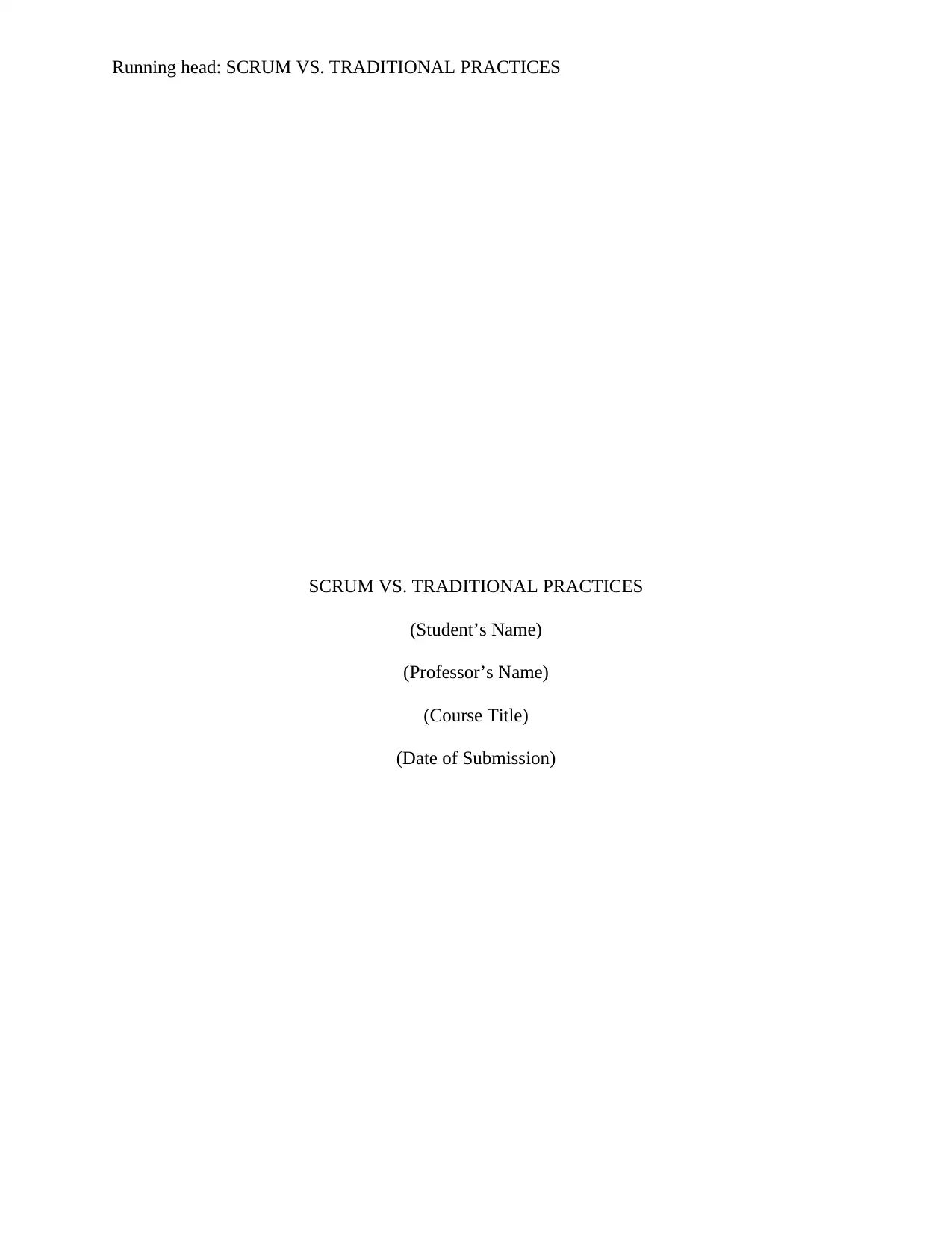
Running head: SCRUM VS. TRADITIONAL PRACTICES
SCRUM VS. TRADITIONAL PRACTICES
(Student’s Name)
(Professor’s Name)
(Course Title)
(Date of Submission)
SCRUM VS. TRADITIONAL PRACTICES
(Student’s Name)
(Professor’s Name)
(Course Title)
(Date of Submission)
Paraphrase This Document
Need a fresh take? Get an instant paraphrase of this document with our AI Paraphraser
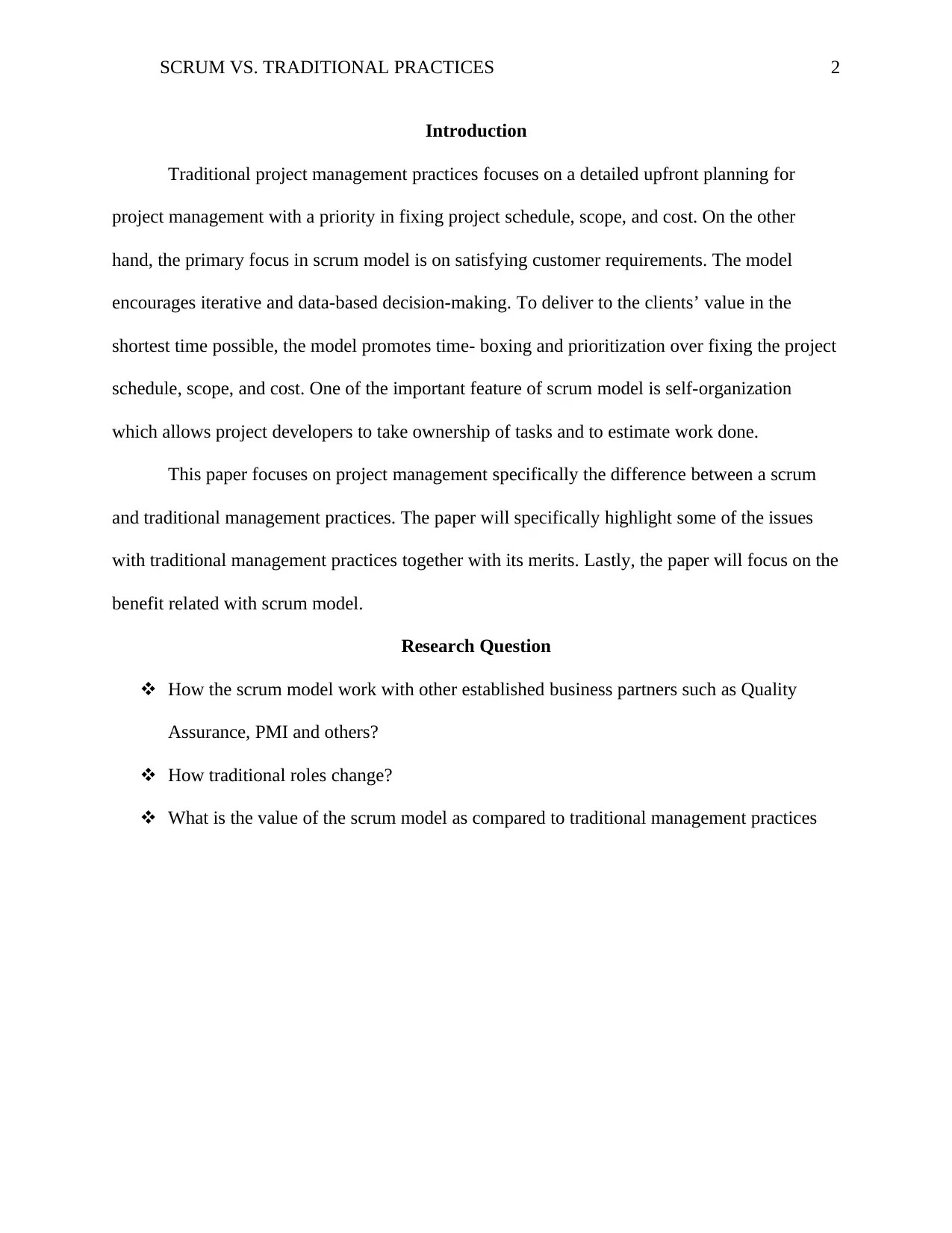
SCRUM VS. TRADITIONAL PRACTICES 2
Introduction
Traditional project management practices focuses on a detailed upfront planning for
project management with a priority in fixing project schedule, scope, and cost. On the other
hand, the primary focus in scrum model is on satisfying customer requirements. The model
encourages iterative and data-based decision-making. To deliver to the clients’ value in the
shortest time possible, the model promotes time- boxing and prioritization over fixing the project
schedule, scope, and cost. One of the important feature of scrum model is self-organization
which allows project developers to take ownership of tasks and to estimate work done.
This paper focuses on project management specifically the difference between a scrum
and traditional management practices. The paper will specifically highlight some of the issues
with traditional management practices together with its merits. Lastly, the paper will focus on the
benefit related with scrum model.
Research Question
How the scrum model work with other established business partners such as Quality
Assurance, PMI and others?
How traditional roles change?
What is the value of the scrum model as compared to traditional management practices
Introduction
Traditional project management practices focuses on a detailed upfront planning for
project management with a priority in fixing project schedule, scope, and cost. On the other
hand, the primary focus in scrum model is on satisfying customer requirements. The model
encourages iterative and data-based decision-making. To deliver to the clients’ value in the
shortest time possible, the model promotes time- boxing and prioritization over fixing the project
schedule, scope, and cost. One of the important feature of scrum model is self-organization
which allows project developers to take ownership of tasks and to estimate work done.
This paper focuses on project management specifically the difference between a scrum
and traditional management practices. The paper will specifically highlight some of the issues
with traditional management practices together with its merits. Lastly, the paper will focus on the
benefit related with scrum model.
Research Question
How the scrum model work with other established business partners such as Quality
Assurance, PMI and others?
How traditional roles change?
What is the value of the scrum model as compared to traditional management practices
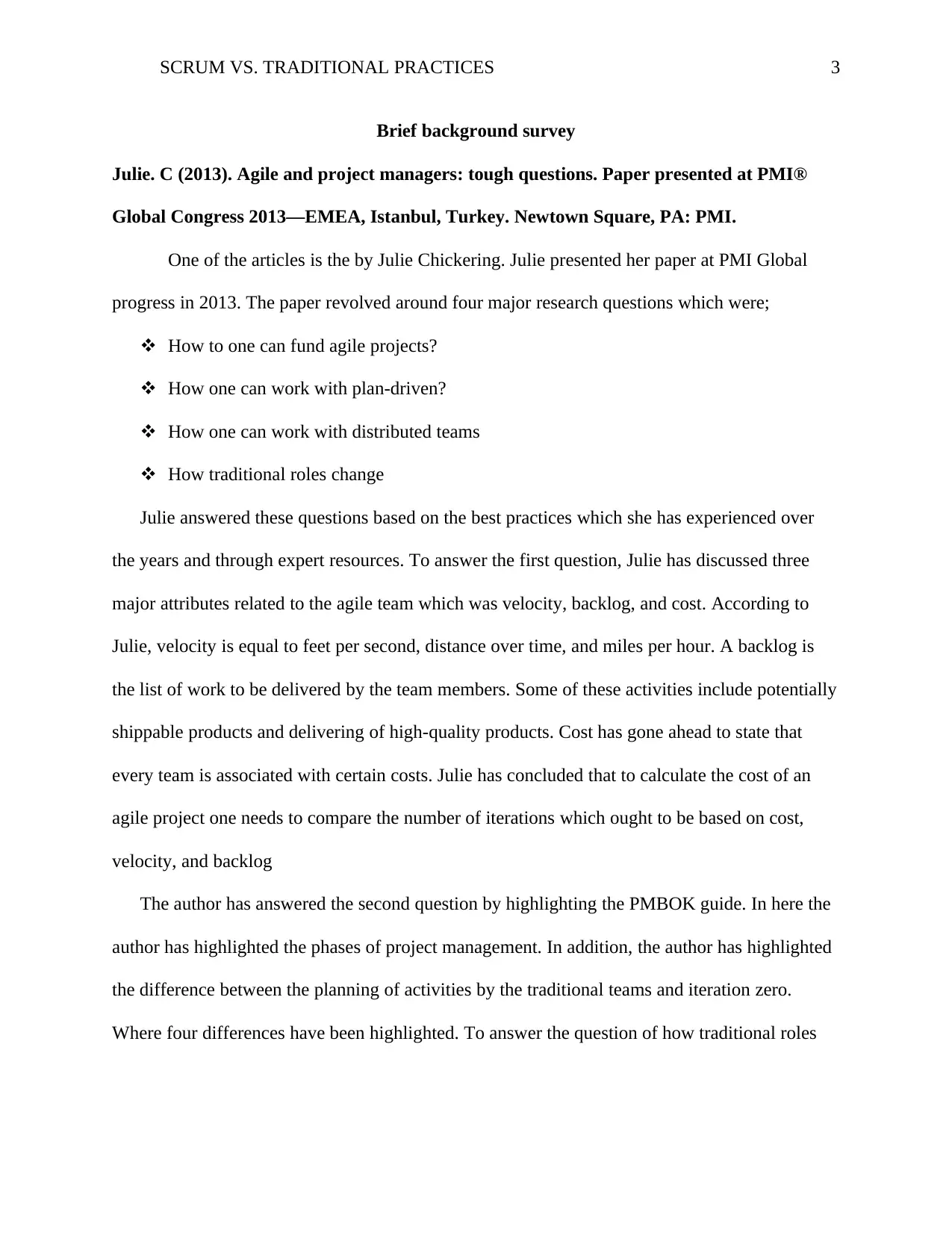
SCRUM VS. TRADITIONAL PRACTICES 3
Brief background survey
Julie. C (2013). Agile and project managers: tough questions. Paper presented at PMI®
Global Congress 2013—EMEA, Istanbul, Turkey. Newtown Square, PA: PMI.
One of the articles is the by Julie Chickering. Julie presented her paper at PMI Global
progress in 2013. The paper revolved around four major research questions which were;
How to one can fund agile projects?
How one can work with plan-driven?
How one can work with distributed teams
How traditional roles change
Julie answered these questions based on the best practices which she has experienced over
the years and through expert resources. To answer the first question, Julie has discussed three
major attributes related to the agile team which was velocity, backlog, and cost. According to
Julie, velocity is equal to feet per second, distance over time, and miles per hour. A backlog is
the list of work to be delivered by the team members. Some of these activities include potentially
shippable products and delivering of high-quality products. Cost has gone ahead to state that
every team is associated with certain costs. Julie has concluded that to calculate the cost of an
agile project one needs to compare the number of iterations which ought to be based on cost,
velocity, and backlog
The author has answered the second question by highlighting the PMBOK guide. In here the
author has highlighted the phases of project management. In addition, the author has highlighted
the difference between the planning of activities by the traditional teams and iteration zero.
Where four differences have been highlighted. To answer the question of how traditional roles
Brief background survey
Julie. C (2013). Agile and project managers: tough questions. Paper presented at PMI®
Global Congress 2013—EMEA, Istanbul, Turkey. Newtown Square, PA: PMI.
One of the articles is the by Julie Chickering. Julie presented her paper at PMI Global
progress in 2013. The paper revolved around four major research questions which were;
How to one can fund agile projects?
How one can work with plan-driven?
How one can work with distributed teams
How traditional roles change
Julie answered these questions based on the best practices which she has experienced over
the years and through expert resources. To answer the first question, Julie has discussed three
major attributes related to the agile team which was velocity, backlog, and cost. According to
Julie, velocity is equal to feet per second, distance over time, and miles per hour. A backlog is
the list of work to be delivered by the team members. Some of these activities include potentially
shippable products and delivering of high-quality products. Cost has gone ahead to state that
every team is associated with certain costs. Julie has concluded that to calculate the cost of an
agile project one needs to compare the number of iterations which ought to be based on cost,
velocity, and backlog
The author has answered the second question by highlighting the PMBOK guide. In here the
author has highlighted the phases of project management. In addition, the author has highlighted
the difference between the planning of activities by the traditional teams and iteration zero.
Where four differences have been highlighted. To answer the question of how traditional roles
⊘ This is a preview!⊘
Do you want full access?
Subscribe today to unlock all pages.

Trusted by 1+ million students worldwide
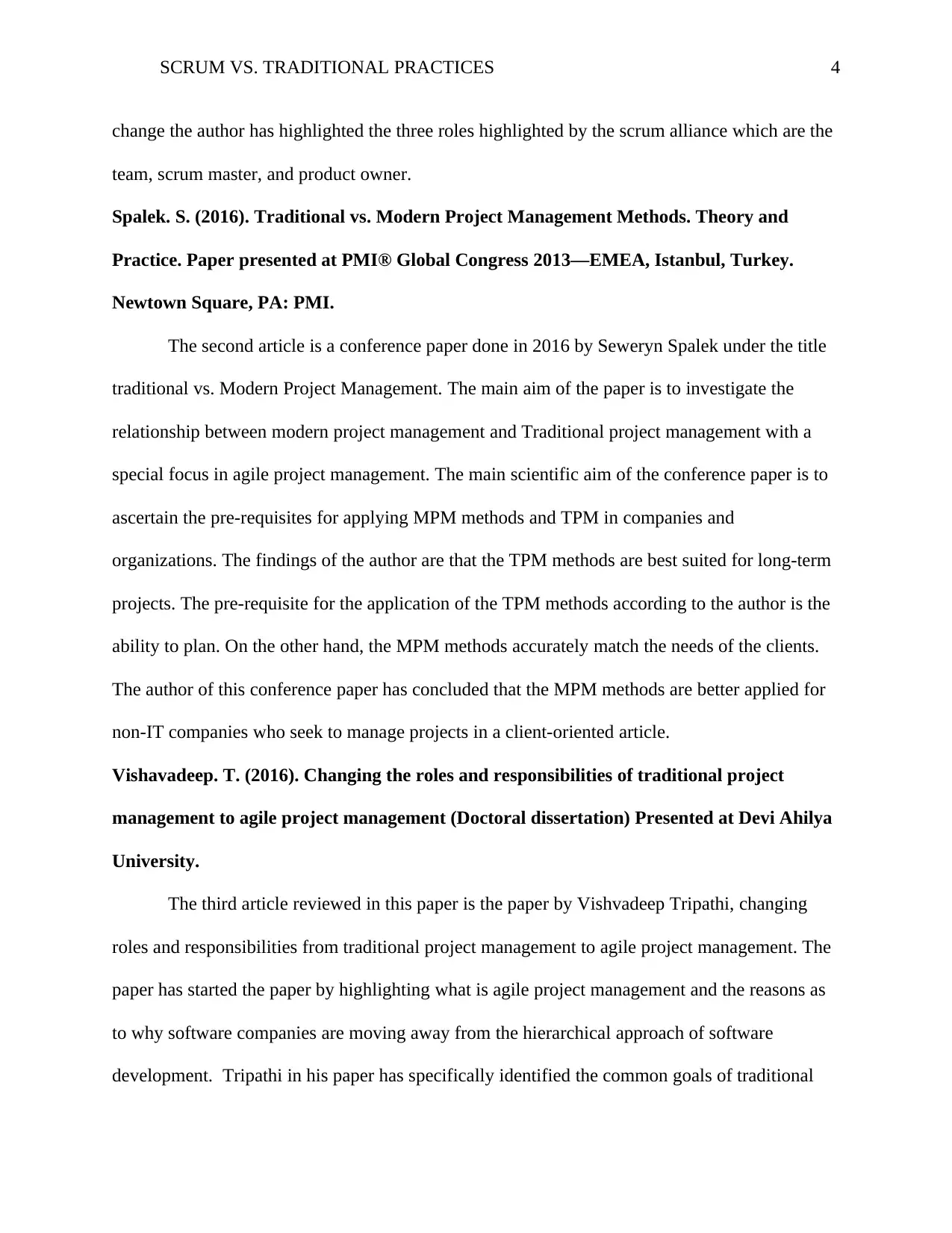
SCRUM VS. TRADITIONAL PRACTICES 4
change the author has highlighted the three roles highlighted by the scrum alliance which are the
team, scrum master, and product owner.
Spalek. S. (2016). Traditional vs. Modern Project Management Methods. Theory and
Practice. Paper presented at PMI® Global Congress 2013—EMEA, Istanbul, Turkey.
Newtown Square, PA: PMI.
The second article is a conference paper done in 2016 by Seweryn Spalek under the title
traditional vs. Modern Project Management. The main aim of the paper is to investigate the
relationship between modern project management and Traditional project management with a
special focus in agile project management. The main scientific aim of the conference paper is to
ascertain the pre-requisites for applying MPM methods and TPM in companies and
organizations. The findings of the author are that the TPM methods are best suited for long-term
projects. The pre-requisite for the application of the TPM methods according to the author is the
ability to plan. On the other hand, the MPM methods accurately match the needs of the clients.
The author of this conference paper has concluded that the MPM methods are better applied for
non-IT companies who seek to manage projects in a client-oriented article.
Vishavadeep. T. (2016). Changing the roles and responsibilities of traditional project
management to agile project management (Doctoral dissertation) Presented at Devi Ahilya
University.
The third article reviewed in this paper is the paper by Vishvadeep Tripathi, changing
roles and responsibilities from traditional project management to agile project management. The
paper has started the paper by highlighting what is agile project management and the reasons as
to why software companies are moving away from the hierarchical approach of software
development. Tripathi in his paper has specifically identified the common goals of traditional
change the author has highlighted the three roles highlighted by the scrum alliance which are the
team, scrum master, and product owner.
Spalek. S. (2016). Traditional vs. Modern Project Management Methods. Theory and
Practice. Paper presented at PMI® Global Congress 2013—EMEA, Istanbul, Turkey.
Newtown Square, PA: PMI.
The second article is a conference paper done in 2016 by Seweryn Spalek under the title
traditional vs. Modern Project Management. The main aim of the paper is to investigate the
relationship between modern project management and Traditional project management with a
special focus in agile project management. The main scientific aim of the conference paper is to
ascertain the pre-requisites for applying MPM methods and TPM in companies and
organizations. The findings of the author are that the TPM methods are best suited for long-term
projects. The pre-requisite for the application of the TPM methods according to the author is the
ability to plan. On the other hand, the MPM methods accurately match the needs of the clients.
The author of this conference paper has concluded that the MPM methods are better applied for
non-IT companies who seek to manage projects in a client-oriented article.
Vishavadeep. T. (2016). Changing the roles and responsibilities of traditional project
management to agile project management (Doctoral dissertation) Presented at Devi Ahilya
University.
The third article reviewed in this paper is the paper by Vishvadeep Tripathi, changing
roles and responsibilities from traditional project management to agile project management. The
paper has started the paper by highlighting what is agile project management and the reasons as
to why software companies are moving away from the hierarchical approach of software
development. Tripathi in his paper has specifically identified the common goals of traditional
Paraphrase This Document
Need a fresh take? Get an instant paraphrase of this document with our AI Paraphraser
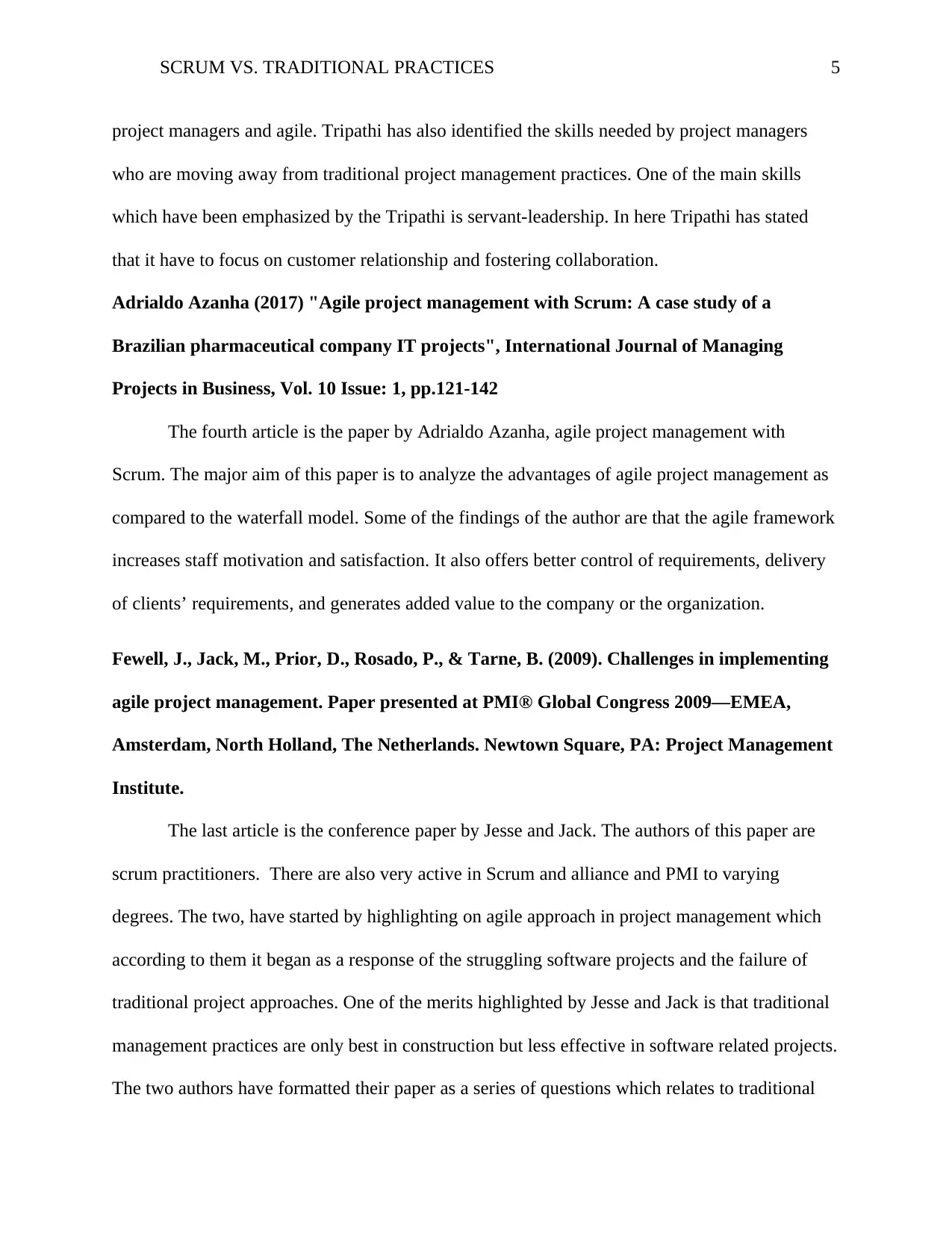
SCRUM VS. TRADITIONAL PRACTICES 5
project managers and agile. Tripathi has also identified the skills needed by project managers
who are moving away from traditional project management practices. One of the main skills
which have been emphasized by the Tripathi is servant-leadership. In here Tripathi has stated
that it have to focus on customer relationship and fostering collaboration.
Adrialdo Azanha (2017) "Agile project management with Scrum: A case study of a
Brazilian pharmaceutical company IT projects", International Journal of Managing
Projects in Business, Vol. 10 Issue: 1, pp.121-142
The fourth article is the paper by Adrialdo Azanha, agile project management with
Scrum. The major aim of this paper is to analyze the advantages of agile project management as
compared to the waterfall model. Some of the findings of the author are that the agile framework
increases staff motivation and satisfaction. It also offers better control of requirements, delivery
of clients’ requirements, and generates added value to the company or the organization.
Fewell, J., Jack, M., Prior, D., Rosado, P., & Tarne, B. (2009). Challenges in implementing
agile project management. Paper presented at PMI® Global Congress 2009—EMEA,
Amsterdam, North Holland, The Netherlands. Newtown Square, PA: Project Management
Institute.
The last article is the conference paper by Jesse and Jack. The authors of this paper are
scrum practitioners. There are also very active in Scrum and alliance and PMI to varying
degrees. The two, have started by highlighting on agile approach in project management which
according to them it began as a response of the struggling software projects and the failure of
traditional project approaches. One of the merits highlighted by Jesse and Jack is that traditional
management practices are only best in construction but less effective in software related projects.
The two authors have formatted their paper as a series of questions which relates to traditional
project managers and agile. Tripathi has also identified the skills needed by project managers
who are moving away from traditional project management practices. One of the main skills
which have been emphasized by the Tripathi is servant-leadership. In here Tripathi has stated
that it have to focus on customer relationship and fostering collaboration.
Adrialdo Azanha (2017) "Agile project management with Scrum: A case study of a
Brazilian pharmaceutical company IT projects", International Journal of Managing
Projects in Business, Vol. 10 Issue: 1, pp.121-142
The fourth article is the paper by Adrialdo Azanha, agile project management with
Scrum. The major aim of this paper is to analyze the advantages of agile project management as
compared to the waterfall model. Some of the findings of the author are that the agile framework
increases staff motivation and satisfaction. It also offers better control of requirements, delivery
of clients’ requirements, and generates added value to the company or the organization.
Fewell, J., Jack, M., Prior, D., Rosado, P., & Tarne, B. (2009). Challenges in implementing
agile project management. Paper presented at PMI® Global Congress 2009—EMEA,
Amsterdam, North Holland, The Netherlands. Newtown Square, PA: Project Management
Institute.
The last article is the conference paper by Jesse and Jack. The authors of this paper are
scrum practitioners. There are also very active in Scrum and alliance and PMI to varying
degrees. The two, have started by highlighting on agile approach in project management which
according to them it began as a response of the struggling software projects and the failure of
traditional project approaches. One of the merits highlighted by Jesse and Jack is that traditional
management practices are only best in construction but less effective in software related projects.
The two authors have formatted their paper as a series of questions which relates to traditional
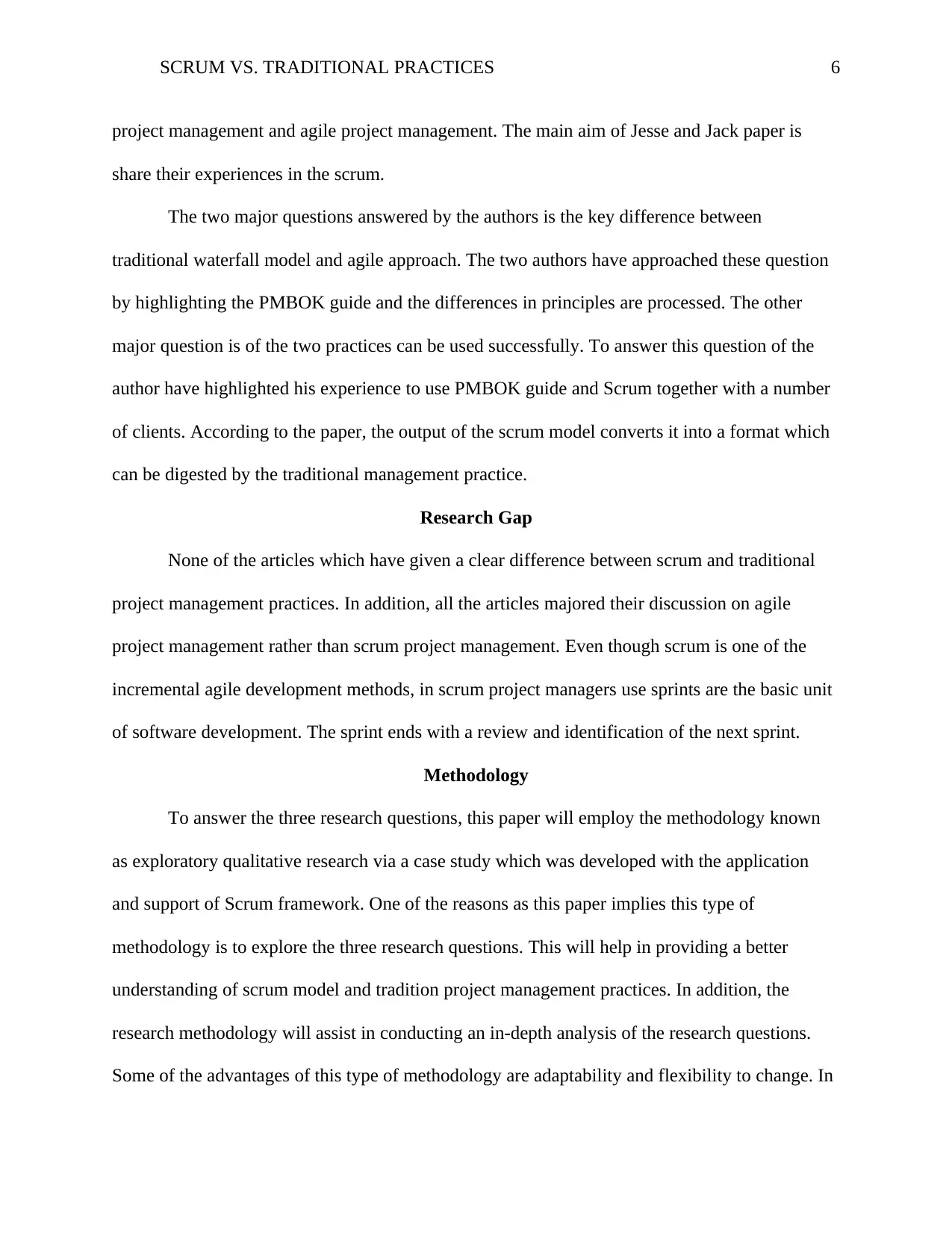
SCRUM VS. TRADITIONAL PRACTICES 6
project management and agile project management. The main aim of Jesse and Jack paper is
share their experiences in the scrum.
The two major questions answered by the authors is the key difference between
traditional waterfall model and agile approach. The two authors have approached these question
by highlighting the PMBOK guide and the differences in principles are processed. The other
major question is of the two practices can be used successfully. To answer this question of the
author have highlighted his experience to use PMBOK guide and Scrum together with a number
of clients. According to the paper, the output of the scrum model converts it into a format which
can be digested by the traditional management practice.
Research Gap
None of the articles which have given a clear difference between scrum and traditional
project management practices. In addition, all the articles majored their discussion on agile
project management rather than scrum project management. Even though scrum is one of the
incremental agile development methods, in scrum project managers use sprints are the basic unit
of software development. The sprint ends with a review and identification of the next sprint.
Methodology
To answer the three research questions, this paper will employ the methodology known
as exploratory qualitative research via a case study which was developed with the application
and support of Scrum framework. One of the reasons as this paper implies this type of
methodology is to explore the three research questions. This will help in providing a better
understanding of scrum model and tradition project management practices. In addition, the
research methodology will assist in conducting an in-depth analysis of the research questions.
Some of the advantages of this type of methodology are adaptability and flexibility to change. In
project management and agile project management. The main aim of Jesse and Jack paper is
share their experiences in the scrum.
The two major questions answered by the authors is the key difference between
traditional waterfall model and agile approach. The two authors have approached these question
by highlighting the PMBOK guide and the differences in principles are processed. The other
major question is of the two practices can be used successfully. To answer this question of the
author have highlighted his experience to use PMBOK guide and Scrum together with a number
of clients. According to the paper, the output of the scrum model converts it into a format which
can be digested by the traditional management practice.
Research Gap
None of the articles which have given a clear difference between scrum and traditional
project management practices. In addition, all the articles majored their discussion on agile
project management rather than scrum project management. Even though scrum is one of the
incremental agile development methods, in scrum project managers use sprints are the basic unit
of software development. The sprint ends with a review and identification of the next sprint.
Methodology
To answer the three research questions, this paper will employ the methodology known
as exploratory qualitative research via a case study which was developed with the application
and support of Scrum framework. One of the reasons as this paper implies this type of
methodology is to explore the three research questions. This will help in providing a better
understanding of scrum model and tradition project management practices. In addition, the
research methodology will assist in conducting an in-depth analysis of the research questions.
Some of the advantages of this type of methodology are adaptability and flexibility to change. In
⊘ This is a preview!⊘
Do you want full access?
Subscribe today to unlock all pages.

Trusted by 1+ million students worldwide
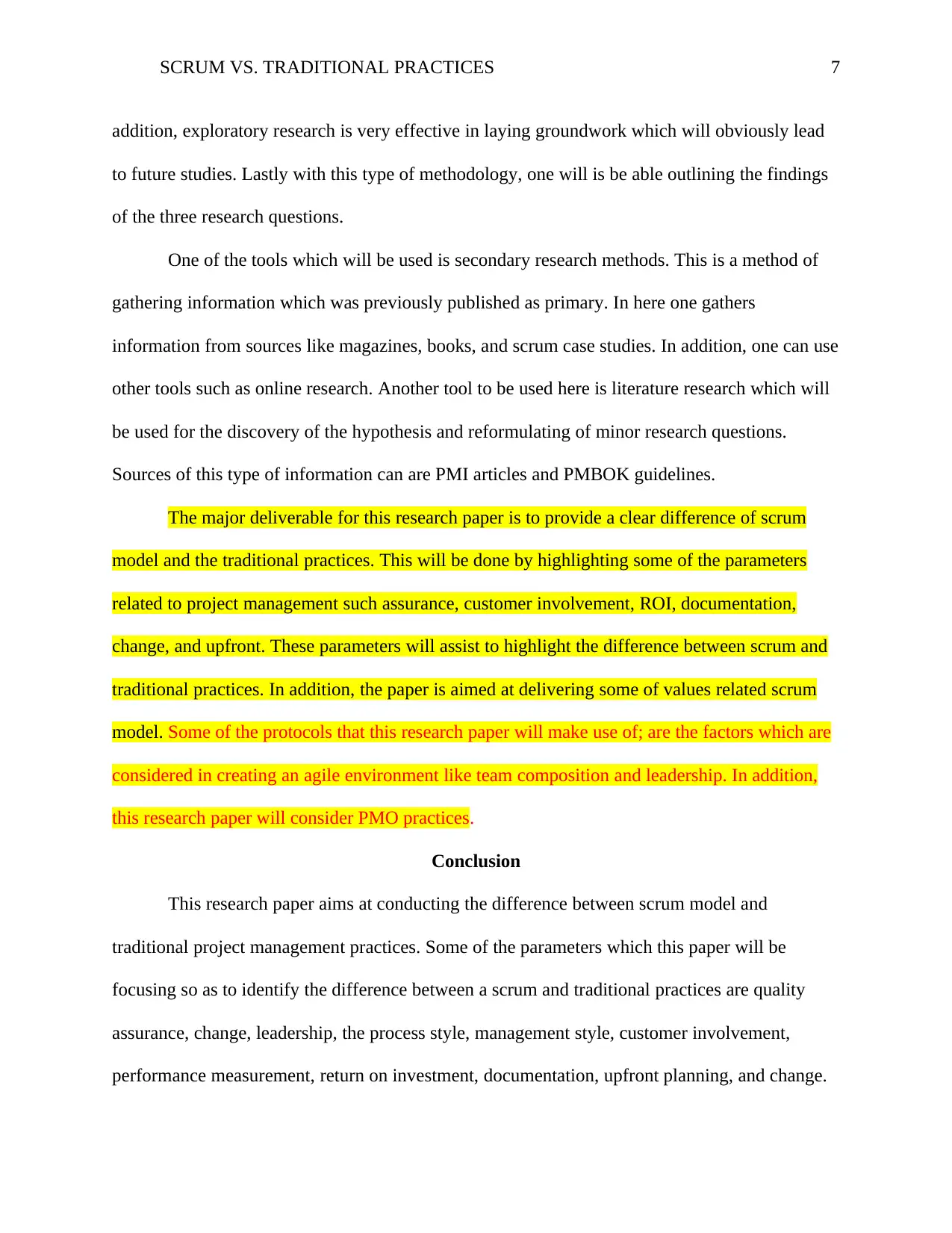
SCRUM VS. TRADITIONAL PRACTICES 7
addition, exploratory research is very effective in laying groundwork which will obviously lead
to future studies. Lastly with this type of methodology, one will is be able outlining the findings
of the three research questions.
One of the tools which will be used is secondary research methods. This is a method of
gathering information which was previously published as primary. In here one gathers
information from sources like magazines, books, and scrum case studies. In addition, one can use
other tools such as online research. Another tool to be used here is literature research which will
be used for the discovery of the hypothesis and reformulating of minor research questions.
Sources of this type of information can are PMI articles and PMBOK guidelines.
The major deliverable for this research paper is to provide a clear difference of scrum
model and the traditional practices. This will be done by highlighting some of the parameters
related to project management such assurance, customer involvement, ROI, documentation,
change, and upfront. These parameters will assist to highlight the difference between scrum and
traditional practices. In addition, the paper is aimed at delivering some of values related scrum
model. Some of the protocols that this research paper will make use of; are the factors which are
considered in creating an agile environment like team composition and leadership. In addition,
this research paper will consider PMO practices.
Conclusion
This research paper aims at conducting the difference between scrum model and
traditional project management practices. Some of the parameters which this paper will be
focusing so as to identify the difference between a scrum and traditional practices are quality
assurance, change, leadership, the process style, management style, customer involvement,
performance measurement, return on investment, documentation, upfront planning, and change.
addition, exploratory research is very effective in laying groundwork which will obviously lead
to future studies. Lastly with this type of methodology, one will is be able outlining the findings
of the three research questions.
One of the tools which will be used is secondary research methods. This is a method of
gathering information which was previously published as primary. In here one gathers
information from sources like magazines, books, and scrum case studies. In addition, one can use
other tools such as online research. Another tool to be used here is literature research which will
be used for the discovery of the hypothesis and reformulating of minor research questions.
Sources of this type of information can are PMI articles and PMBOK guidelines.
The major deliverable for this research paper is to provide a clear difference of scrum
model and the traditional practices. This will be done by highlighting some of the parameters
related to project management such assurance, customer involvement, ROI, documentation,
change, and upfront. These parameters will assist to highlight the difference between scrum and
traditional practices. In addition, the paper is aimed at delivering some of values related scrum
model. Some of the protocols that this research paper will make use of; are the factors which are
considered in creating an agile environment like team composition and leadership. In addition,
this research paper will consider PMO practices.
Conclusion
This research paper aims at conducting the difference between scrum model and
traditional project management practices. Some of the parameters which this paper will be
focusing so as to identify the difference between a scrum and traditional practices are quality
assurance, change, leadership, the process style, management style, customer involvement,
performance measurement, return on investment, documentation, upfront planning, and change.
Paraphrase This Document
Need a fresh take? Get an instant paraphrase of this document with our AI Paraphraser
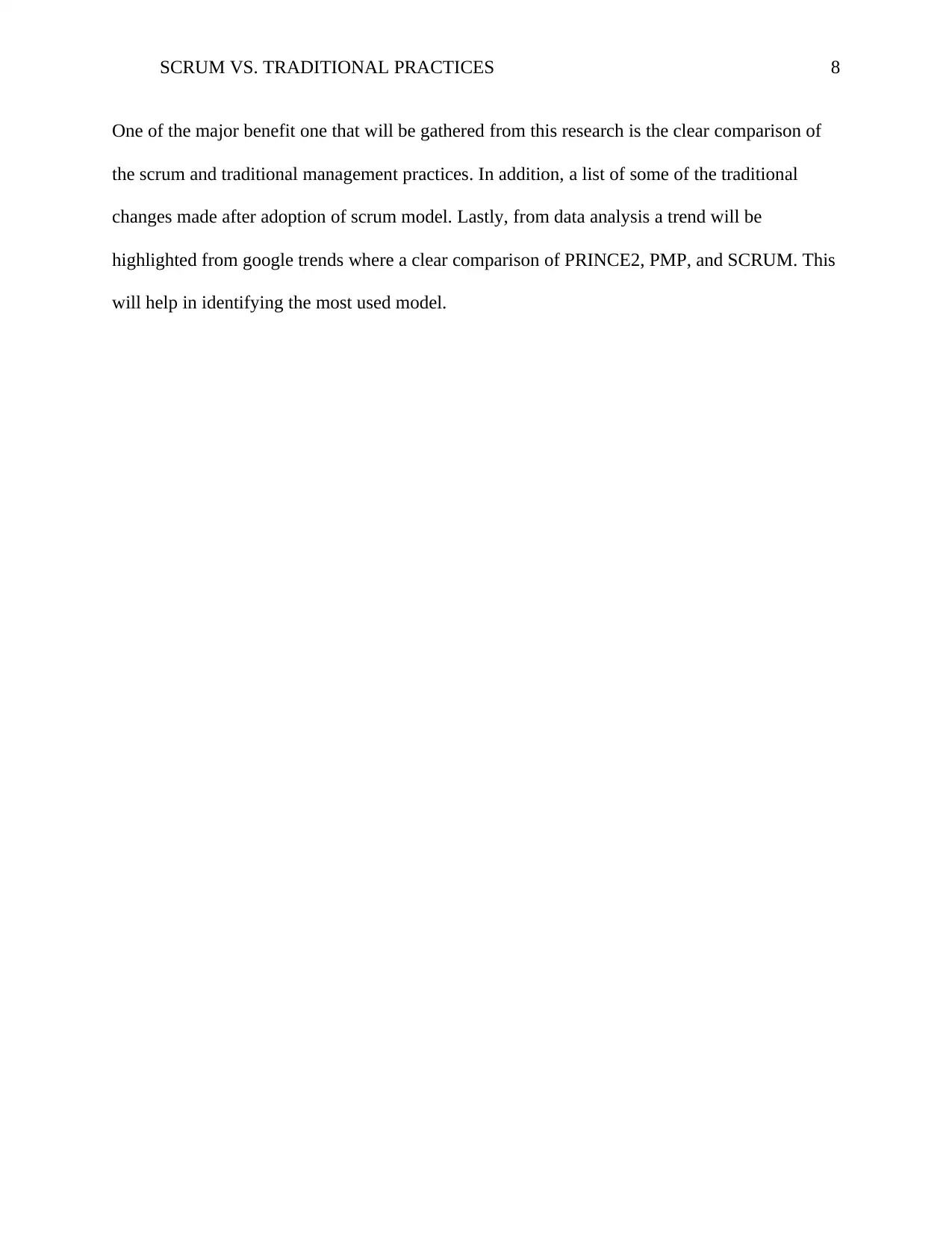
SCRUM VS. TRADITIONAL PRACTICES 8
One of the major benefit one that will be gathered from this research is the clear comparison of
the scrum and traditional management practices. In addition, a list of some of the traditional
changes made after adoption of scrum model. Lastly, from data analysis a trend will be
highlighted from google trends where a clear comparison of PRINCE2, PMP, and SCRUM. This
will help in identifying the most used model.
One of the major benefit one that will be gathered from this research is the clear comparison of
the scrum and traditional management practices. In addition, a list of some of the traditional
changes made after adoption of scrum model. Lastly, from data analysis a trend will be
highlighted from google trends where a clear comparison of PRINCE2, PMP, and SCRUM. This
will help in identifying the most used model.
1 out of 8
Related Documents
Your All-in-One AI-Powered Toolkit for Academic Success.
+13062052269
info@desklib.com
Available 24*7 on WhatsApp / Email
![[object Object]](/_next/static/media/star-bottom.7253800d.svg)
Unlock your academic potential
Copyright © 2020–2025 A2Z Services. All Rights Reserved. Developed and managed by ZUCOL.





